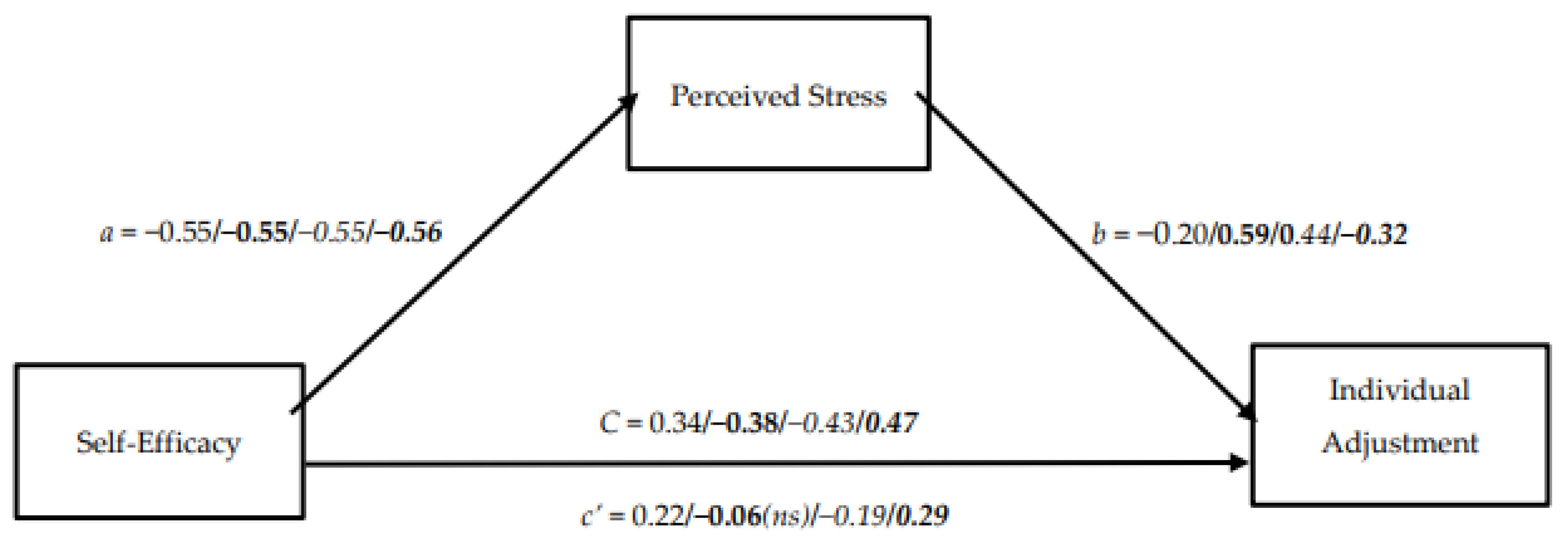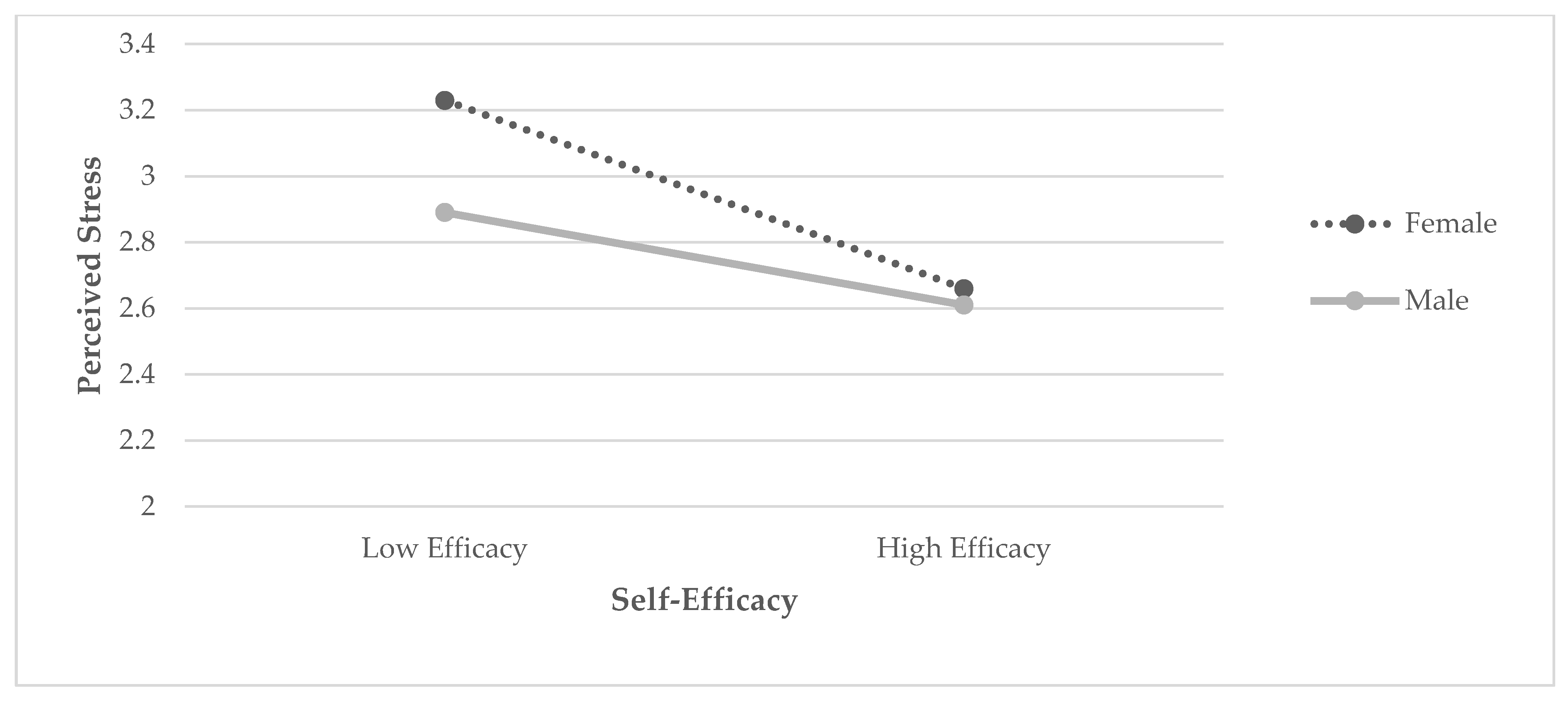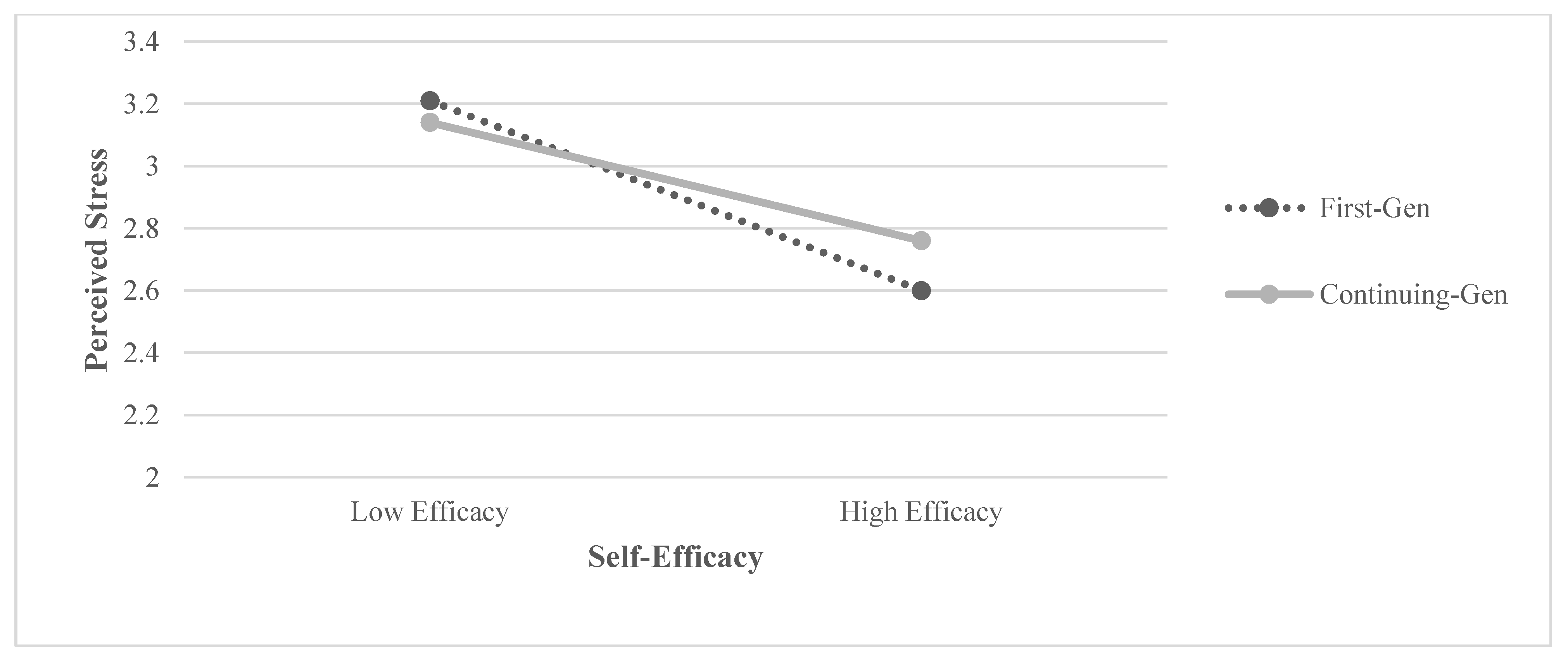Self-Efficacy, Perceived Stress, and Individual Adjustment among College-Attending Emerging Adults
Abstract
1. Introduction
1.1. Self-Efficacy
1.2. Self-Efficacy and Individual Adjustment
1.3. Self-Efficacy, Perceived Stress, and Adjustment
1.4. Moderator Effects
1.4.1. Sex
1.4.2. Race/Ethnicity
1.4.3. School Year
1.4.4. First-Generation
1.5. Current Study
2. Materials and Methods
2.1. Procedure and Participants
2.2. Measures
2.2.1. Self-Efficacy
2.2.2. Perceived Stress
2.2.3. Overall Academic Satisfaction
2.2.4. Depressive Symptoms
2.2.5. Loneliness
2.2.6. Subjective Physical Health
2.3. Analysis Strategy
3. Results
3.1. Direct and Indirect Effects
3.2. Conditional Direct and Indirect Effects
4. Discussion
4.1. Limitations
4.2. Implications for Practice
5. Conclusions
Author Contributions
Funding
Institutional Review Board Statement
Informed Consent Statement
Data Availability Statement
Conflicts of Interest
References
- Arnett, J.J. Emerging adulthood: A theory of development from the late teens through the twenties. Amer. Psychol. 2000, 55, 469–480. [Google Scholar] [CrossRef]
- Arnett, J.J. Adolescence and Emerging Adulthood: A Cultural Approach, 3rd ed.; Pearson: Upper Saddle River, NJ, USA, 2007. [Google Scholar]
- Bayram, N.; Bilgel, N. The prevalence and socio-demographic correlations of depression, anxiety and stress among a group of university students. Soc. Psychiatry Psychiatr. Epidemiol. 2008, 43, 667–672. [Google Scholar] [CrossRef] [PubMed]
- Conley, C.S.; Kirsch, A.C.; Dickson, D.A.; Bryant, F.B. Negotiating the transition to college: Developmental trajectories and gender differences in psychological functioning, cognitive-affective strategies, and social well-being. Emerg. Adulthood 2014, 2, 195–210. [Google Scholar] [CrossRef]
- Lee, C.-Y.S.; Goldstein, S.E.; Dik, B.J. The relational context of social support in young adults: Links with stress and well-being. J. Adult Dev. 2018, 25, 25–36. [Google Scholar] [CrossRef]
- National Student Clearinghouse Research Center. Snapshot Report: First-Year Persistence and Retention 2018 Beginning Cohort. Available online: https://nscresearchcenter.org/wp-content/uploads/PersistenceRetention2020.pdf (accessed on 17 September 2022).
- Redford, J.; Hoyer, K.M.; National Center for Education Statistics; American Institutes for Research. Stats in Brief: First-Generation and Continuing-Generation College Students: A Comparison of High School and Postsecondary Experiences. Available online: https://nces.ed.gov/pubs2018/2018009.pdf (accessed on 17 September 2022).
- Webb, O.J.; Cotton, D.R.E. Deciphering the sophomore slump: Changes to student perceptions during the undergraduate journey. High. Educ. Int. J. High. Educ. Res. 2019, 77, 173–190. [Google Scholar] [CrossRef]
- Acharya, L.; Jin, L.; Collins, W. College life is stressful today—Emerging stressors and depressive symptoms in college students. J. Amer. Coll. Health 2018, 66, 655–664. [Google Scholar] [CrossRef]
- Dalgard, O.S.; Dowrick, C.; Lehtinen, V.; Vazquez-Barquero, J.L.; Casey, P.; Wilkinson, G.; Ayuso-Mateos, J.L.; Page, H.; Dunn, G. Negative life events, social support and gender difference in depression: A multinational community survey with data from the ODIN study. Soc. Psychiatry Psychiatr. Epidem. 2006, 41, 444–451. [Google Scholar] [CrossRef]
- Galaif, E.R.; Sussman, S.; Chou, C.-P.; Wills, T.A. Longitudinal relations among depression, stress, and coping in high risk youth. J. Youth Adoles. 2003, 32, 243–258. [Google Scholar] [CrossRef]
- Bandura, A. Self-Efficacy: Toward a unifying theory of behavioral change. Psych. Rev. 1977, 84, 191–215. [Google Scholar] [CrossRef]
- Tinto, V. Through the Eyes of Students. J. Coll. Stud. Retent. Res. Theory Pract. 2017, 19, 254–269. [Google Scholar] [CrossRef]
- Brady-Amoon, P.; Fuertes, J.N. Self-efficacy, self-rated abilities, adjustment, and academic performance. J. Couns. Dev. 2011, 89, 431–438. [Google Scholar] [CrossRef]
- Reed-Fitzke, K. The role of self-concepts in emerging adult depression: A systematic research synthesis. J. Adult Dev. 2020, 27, 36–48. [Google Scholar] [CrossRef]
- Dalton, E.D.; Hammen, C.L. Independent and relative effects of stress, depressive symptoms, and affect on college students’ daily health behaviors. J. Behav. Med. 2018, 41, 863–874. [Google Scholar] [CrossRef] [PubMed]
- Stoliker, B.E.; Lafreniere, K.D. The influence of perceived stress, loneliness, and learning burnout on university students’ educational experience. Coll. Stud. J. 2015, 49, 146–160. [Google Scholar]
- Burger, K.; Samuel, R. The role of perceived stress and self-efficacy in young people’s life satisfaction: A longitudinal study. J. Youth Adolesc. 2017, 46, 78–90. [Google Scholar] [CrossRef] [PubMed]
- Lee, J.; Kim, E.; Wachholtz, A. The effect of perceived stress on life satisfaction: The mediating effect of self-efficacy. Ch’ongsonyonhak Yongu 2016, 23, 29–47. [Google Scholar] [CrossRef]
- Bandura, A. Adolescent Development from an Agentic Perspective. In Self-Efficacy Beliefs of Adolescents; Pajares, F., Urdan, T., Eds.; Information Age Publishing: Charlotte, NC, USA, 2006; pp. 1–43. [Google Scholar]
- Hermann, K.S.; Betz, N.E. Path models of the relationships of instrumentality and expressiveness, social self-efficacy, and self-esteem to depressive symptoms in college students. J. Soc. Clin. Psychol. 2006, 25, 1086–1106. [Google Scholar] [CrossRef]
- King, C.A.; Wu, J.; Niranjan, S. Social support, self-efficacy and depression of college students. Intern. J. Lib. Arts Soc. Sci. 2014, 2, 51–64. [Google Scholar]
- Oliver, J.M.; Paull, J.C. Self-esteem and self-efficacy; perceived parenting and family climate; and depression in university students. J. Clin. Psychol. 1995, 51, 467–481. [Google Scholar] [CrossRef]
- Saltzman, K.M.; Holahan, C.J. Social support, self-efficacy and depressive symptoms: An integrative model. J. Soc. Clin. Psych. 2002, 21, 309–322. [Google Scholar] [CrossRef]
- Wei, M.; Russell, D.W.; Zakalik, R.A. Adult attachment, social self-efficacy, self-disclosure, loneliness, and subsequent depression for freshman college students: A longitudinal study. J. Couns. Psych. 2005, 52, 602–614. [Google Scholar] [CrossRef]
- Javed, S.; Nizami, N. Self-efficacy in relation to adjustment among college students. Indian J. Posit. Psychol. 2012, 3, 422–424. [Google Scholar]
- Choi, H.-J.; Lee, E.-J. Mediation effects of self-efficacy between academic stress and college adjustment in first year nursing students. J. Korean Acad. Fundam. Nurs. 2012, 19, 261–268. [Google Scholar] [CrossRef]
- Moon, W.-H.; Sim, H.-S. Relationships between self-efficacy, stress, depression and adjustment of college students. Indian J. Sci. Technol. 2015, 8, 1–8. [Google Scholar] [CrossRef]
- Valenti, G.D.; Faraci, P. Predicting university adjustment from coping-styles, self-esteem, self-efficacy, and personality: Findings from a survey in a sample of Italian students. Euro. J. Investig. Health Psych. Educ. 2021, 11, 894–907. [Google Scholar] [CrossRef] [PubMed]
- Yusoff, Y.M. Self-efficacy, perceived social support, and psychological adjustment in international undergraduate students in a public higher education institution in Malaysia. J. Stud. Int. Educ. 2012, 16, 353–371. [Google Scholar] [CrossRef]
- Elliott, D.C. Trailblazing: Exploring first-generation college students’ self-efficacy beliefs and academic adjustment. J. First-Year Exper. Stud. Transit. 2014, 26, 29–49. [Google Scholar]
- Khan, M. Academic self-efficacy, coping, and academic performance in college. Intl J. Undergrad. Res. Creat. Act. 2013, 5, 1–11. [Google Scholar] [CrossRef]
- Lent, R.W.; do Céu Taveira, M.; Sheu, H.B.; Singley, D. Social cognitive predictors of academic adjustment and life satisfaction in Portuguese college students: A longitudinal analysis. J. Vocat. Behav. 2009, 74, 190–198. [Google Scholar] [CrossRef]
- Valentine, J.C.; DuBois, D.L.; Cooper, H. The relation between self-beliefs and academic achievement: A meta-analytic review. Educ. Psychol. 2004, 39, 111–133. [Google Scholar] [CrossRef]
- Vuong, M.; Brown-Welty, S.; Tracz, S. The effects of self-efficacy on academic success of first-generation college sophomore students. J. Coll. Stud. Dev. 2010, 51, 50–64. [Google Scholar] [CrossRef]
- Zajacova, A.; Lynch, S.M.; Espenshade, T.J. Self-Efficacy, Stress, and Academic Success in College. Res. High. Ed. 2005, 46, 677–706. [Google Scholar] [CrossRef]
- Zhao, F.-F.; Lei, X.-L.; He, W.; Gu, Y.-H.; Li, D.-W. The moderating effect of self-efficacy. Intl. J. Nurs. Pract. 2015, 21, 401–409. [Google Scholar] [CrossRef] [PubMed]
- Dixon Rayle, A.; Arredondo, P.; Kurpius, S.E.R. Educational self-efficacy of college women: Implications for theory, research, and practice. J. Couns. Dev. 2005, 83, 361–366. [Google Scholar] [CrossRef]
- Chemers, M.M.; Hu, L.; Garcia, B.F. Academic self-efficacy and first-year college student performance and adjustment. J. Educ. Psychol. 2001, 93, 55–64. [Google Scholar] [CrossRef]
- Towbes, L.C.; Cohen, L.H. Chronic stress in the lives of college students: Scale development and prospective prediction of distress. J. Youth Adolesc. 1996, 25, 199–217. [Google Scholar] [CrossRef]
- Goldin, C.; Katz, L.F.; Kuziemko, I. The homecoming of American college women: The reversal of the college gender gap. J. Econ. Perspect. 2006, 20, 133–156. [Google Scholar] [CrossRef]
- Lipson, S.K.; Kern, A.; Eisenberg, D.; Breland-Noble, A.M. Mental health disparities among college students of color. J. Adolesc. Health 2018, 63, 348–356. [Google Scholar] [CrossRef]
- National Center of Education Statistics. Percentage of 18- to 24-Year-Olds Enrolled in College, by Level of Institution and Sex and Race/Ethnicity of Student: 1970 through 2018. Available online: https://nces.ed.gov/programs/digest/d19/tables/dt19_302.60.asp (accessed on 17 September 2022).
- Nolen-Hoeksema, S. Gender differences in depression. Curr. Dir. Psychol. Sci. 2001, 10, 173–176. [Google Scholar] [CrossRef]
- Maciejewski, P.K.; Prigerson, H.G.; Mazure, C.M. Sex differences in event-related risk for major depression. Psychol. Med. 2001, 31, 593–604. [Google Scholar] [CrossRef]
- Kononovas, K.; Dallas, T. A cross-cultural comparison of perceived stress and self-efficacy across Japanese, U.S. and Lithuanian students. Psichologija 2009, 39, 59–70. [Google Scholar] [CrossRef]
- Morton, S.; Mergler, A.; Boman, P. Managing the transition: The role of optimism and self-efficacy for first-year Australian university students. Aust. J. Guid. Couns. 2014, 24, 90–108. [Google Scholar] [CrossRef]
- Coffman, D.L.; Gilligan, T.D. Social support, stress, and self-efficacy: Effects on students’ satisfaction. J. Coll. Stud. Retent. Res. Theory Pract. 2002, 4, 53–66. [Google Scholar] [CrossRef]
- Wrench, A.; Garrett, R.; King, S. Guessing where the goal posts are: Managing health and well-being during the transition to university studies. J. Youth Stud. 2013, 16, 730–746. [Google Scholar] [CrossRef]
- Garza, K.K.; Bain, S.F.; Kupczynski, L. Resiliency, self-efficacy, and persistence of college seniors in higher education. Res. High. Educ. J. 2014, 26, 1–19. [Google Scholar]
- Graunke, S.S.; Woosley, S.A. An exploration of the factors that affect the academic success of college sophomores. Coll. Stud. J. 2005, 39, 367–377. [Google Scholar]
- Evans, R.; Stansberry, D.; Bullington, K.E.; Burnett, D. First in college: A qualitative exploration of experiences of first-generation students. Inq. J. Va. Community Coll. 2020, 23, 1–32. [Google Scholar]
- Wang, C.-C.D.C.; Castañeda-Sound, C. The role of generational status, self-esteem, academic self-efficacy, and perceived social support in college students’ psychological well-being. J. Coll. Couns. 2008, 11, 101–118. [Google Scholar] [CrossRef]
- Schwarzer, R.; Jerusalem, M. Generalized Self-Efficacy Scale. In Measures in Health Psychology: A User’s Portfolio; Weinman, J., Wright, S., Johnston, M., Eds.; NFER-NELSON: Windsor, UK, 1995; pp. 35–37. [Google Scholar]
- Cohen, S.; Williamson, G.M. Perceived Stress in a Probability Sample of the United States. In The Social Psychology of Health; Spacapan, S., Oskamp, S., Eds.; SAGE Publications: Sherman Oaks, CA, USA, 1998; pp. 31–67. [Google Scholar]
- Lee, C.-Y.S.; Dik, B.J.; Barbara, L.A. Intergenerational solidarity and individual adjustment during emerging adulthood. J. Fam. Issues 2016, 37, 1412–1432. [Google Scholar] [CrossRef]
- Radloff, L.S. The CES-D scale: A self-report depression scale for research in the general population. Appl. Psychol. Meas. 1977, 1, 385–401. [Google Scholar] [CrossRef]
- Hays, R.D.; DiMatteo, M.R. A short-form measure of loneliness. J. Personal. Assess. 1987, 51, 69–81. [Google Scholar] [CrossRef] [PubMed]
- Barr, A.B.; Culatta, E.; Simons, R.L. Romantic relationships and health among African American young adults: Linking patterns of relationship quality over time to changes in physical and mental health. J. Health Soc. Behav. 2013, 54, 369–385. [Google Scholar] [CrossRef] [PubMed]
- Christian, L.; Glaser, R.; Porter, K.; Malarkey, W.; Beversdorf, D.; Kiecolt-Glaser, J. Poor self-rated health is associated with elevated inflammatory markers among older adults. Psychoneuroendocrinology 2011, 36, 1495–1504. [Google Scholar] [CrossRef] [PubMed]
- Idler, E.L.; Benyamini, Y. Self-rated health and mortality: A review of twenty-seven community studies. J. Health Soc. Behav. 1997, 38, 21–37. [Google Scholar] [CrossRef] [PubMed]
- Hayes, A.F. Introduction to Mediation, Moderation, and Conditional Process Analysis: A Regression-Based Approach, 2nd ed.; The Guilford Press: New York, NY, USA, 2017. [Google Scholar]
- Aiken, L.S.; West, S.G.; Reno, R.R. Multiple regression: Testing and Interpreting Interactions; SAGE: Thousand Oaks, CA, USA, 1991. [Google Scholar]
- McKay, M.T.; Dempster, M.; Byrne, D.G. An examination of the relationship between self-efficacy and stress in adolescents: The role of gender and self-esteem. J. Youth Stud. 2014, 17, 1131–1151. [Google Scholar] [CrossRef]
- Centers for Disease Control and Prevention. Disparities in Suicide. Available online: https://www.cdc.gov/suicide/facts/disparities-in-suicide.html (accessed on 17 September 2022).
- Gluckman, N. ‘It’s Definitely A Crisis’: Why Women in College Sports are Struggling with Mental Health. Available online: https://www.chronicle.com/article/its-definitely-a-crisis-why-women-in-college-sports-are-struggling-with-mental-health (accessed on 17 September 2022).
- Cataldi, E.F.; Bennett, C.T.; Chen, X.; RTI International. First-Generation Students: College Access, Persistence, and Postbachelor’s Outcomes. Available online: https://nces.ed.gov/pubs2018/2018421.pdf (accessed on 17 September 2022).
- Ewert, S. Fewer diplomas for men: The influence of college experiences on the gender gap in college graduation. J. High. Educ. 2012, 83, 824–846. [Google Scholar] [CrossRef]
- Arnett, J.J. Emerging Adulthood: The Winding Road from the Late Teems through the Twenties, 2nd ed.; Oxford University Press Inc.: Oxford, UK, 2015. [Google Scholar]
- Pajares, F. Self-Efficacy during Childhood and Adolescence: Implications for Teachers and Parents. In Self-Efficacy Beliefs of Adolescents; Pajares, F., Urdan, T., Eds.; Information Age Publishing: Charlotte, NC, USA, 2006; pp. 339–367. [Google Scholar]
- Seegan, P.L.; Welsh, K.L.; Plunkett, S.W.; Merten, M.J.; Sands, T. Neighborhood, parenting, and individual qualities related to adolescent self-efficacy in immigrant families. Fam. Consum. Sci. Res. J. 2012, 40, 348–360. [Google Scholar] [CrossRef]
- Hanson, M. College Dropout Rates. Available online: https://educationdata.org/college-dropout-rates (accessed on 17 September 2022).



| 1. | 2. | 3. | 4. | 5. | 6. | 7. | 8. | 9. | 10. | |
|---|---|---|---|---|---|---|---|---|---|---|
| 1. Gender | — | |||||||||
| 2. Ethnicity | 0.04 | — | ||||||||
| 3. School year | −0.01 | −0.03 | — | |||||||
| 4. First-generation status | −0.03 | 0.05 | −0.12 ** | — | ||||||
| 5. Self-efficacy | −0.04 | 0.06 | 0.14 *** | −0.02 | — | |||||
| 6. Perceived stress | 0.15 *** | −0.03 | −0.06 | 0.04 | −0.41 *** | — | ||||
| 7. Academic satisfaction | 0.19 *** | 0.06 | 0.12 ** | −0.07 | 0.24 *** | −0.22 *** | — | |||
| 8. Depressive symptoms | −0.01 | −0.07 | −0.07 | −0.01 | −0.32 *** | 0.66 *** | −0.27 *** | — | ||
| 9. Loneliness | −0.05 | −0.06 | −0.06 | 0.06 | −0.32 *** | 0.47 *** | −0.18 *** | 0.57 *** | — | |
| 10. Subjective health | −0.05 | 0.03 | 0.03 | −0.01 | 0.25 *** | −0.30 *** | 0.20 *** | −0.28 *** | −0.31 *** | — |
| M | 10.80 | 30.56 | 20.23 | 10.46 | 30.11 | 20.93 | 30.04 | 10.83 | 10.93 | 40.07 |
| SD | 0.40 | 10.14 | 10.10 | 0.50 | 0.46 | 0.62 | 0.69 | 0.56 | 0.63 | 0.87 |
Publisher’s Note: MDPI stays neutral with regard to jurisdictional claims in published maps and institutional affiliations. |
© 2022 by the authors. Licensee MDPI, Basel, Switzerland. This article is an open access article distributed under the terms and conditions of the Creative Commons Attribution (CC BY) license (https://creativecommons.org/licenses/by/4.0/).
Share and Cite
Madson, R.C.; Perrone, P.B.; Goldstein, S.E.; Lee, C.-Y.S. Self-Efficacy, Perceived Stress, and Individual Adjustment among College-Attending Emerging Adults. Youth 2022, 2, 668-680. https://doi.org/10.3390/youth2040047
Madson RC, Perrone PB, Goldstein SE, Lee C-YS. Self-Efficacy, Perceived Stress, and Individual Adjustment among College-Attending Emerging Adults. Youth. 2022; 2(4):668-680. https://doi.org/10.3390/youth2040047
Chicago/Turabian StyleMadson, Rebecca C., Paula B. Perrone, Sara E. Goldstein, and Chih-Yuan Steven Lee. 2022. "Self-Efficacy, Perceived Stress, and Individual Adjustment among College-Attending Emerging Adults" Youth 2, no. 4: 668-680. https://doi.org/10.3390/youth2040047
APA StyleMadson, R. C., Perrone, P. B., Goldstein, S. E., & Lee, C.-Y. S. (2022). Self-Efficacy, Perceived Stress, and Individual Adjustment among College-Attending Emerging Adults. Youth, 2(4), 668-680. https://doi.org/10.3390/youth2040047







